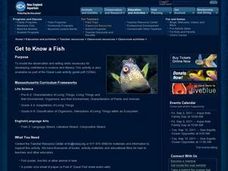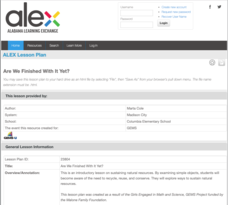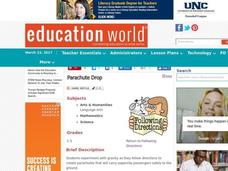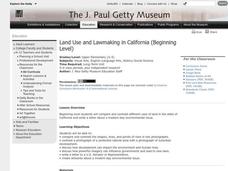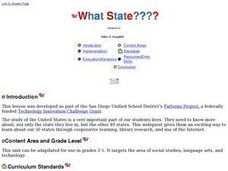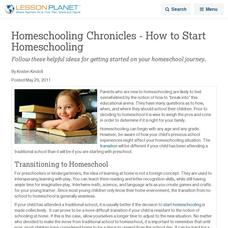Curated OER
Take It Or Leave It
Third graders examine the significance of the Louisiana Purchase and the journey of Lewis and Clark, and discuss "needs" versus "wants". They listen to a story, plan for a journey like Lewis and Clark, create a list of supplies, and...
Curated OER
Through the Eyes of an Owl
Young scholars describe vertebrates in terms of observable body parts and characteristics and describe life cycles of familiar organisms. They identify familiar organisms as part of a food chain or food web and describe their feeding...
Curated OER
Ants
Third graders study the habits and habitats of ants. They research the use of technology as a valuable investigation tool and access other web sites for future research projects. The students make successful decisions while playing SimAnt.
Alabama Learning Exchange
The Solar System
Students explore the Solar System. In this cross-curriculum space instructional activity, students identify the planets, name them in order according to distance from the sun, and describe major characteristics of each planet. Students...
Curated OER
WHERE DOES OUR FOOD COME FROM?
Learners examine the sources, location and availability of local food, develop mapping skills, interact with Elders to gain pertinent information, and examine subsistence issues of the past and present.
Curated OER
The Race
Students play game simulating route turtle hatchlings take from clutch to ocean, and describe threats hatchlings face and how this affects the marine turtle population.
Curated OER
Arthropods at Home- Spider, Isopod, or Any Arthropod
Students design a habitat for an arthropod. In this organisms lesson, students read the book, A House is a House For Me. Students find an arthropod and create a terrarium.
Curated OER
Bye-Bye Trout Song
Learners develop an understanding about what will happen to trout after they are released into the trout stream. In this trout life lesson, students discuss how it feels to release the trout they have cared for. Learners also sing a song...
Curated OER
Get to Know a Fish
Students discover the anatomy of a fish by identifying its body parts. In this oceanography lesson plan, students view a live fish in their classroom and draw a poster of the fish one body part at a time while identifying it....
Alabama Learning Exchange
Are We Finished with It Yet?
Learners recognize the importance of natural resources and that we need to conserve, reuse and recycle them. For this conserving natural resources lesson, students are given one object and must create something with it. Young scholars...
Curated OER
Volcanoes
Third graders study the concept of plate tectonics. In the process they embark in research and construction of a volcano. They complete a web quest while assessing how to research, give oral reports, and create a product.
Alabama Learning Exchange
We Can Dig It!
Third graders understand the process by which fossils and rocks are excavated. In this fossil and rock lesson, 3rd graders explore the job of the paleontologist in a podcast.
Alabama Learning Exchange
On the Farm with Wilbur and Charlotte
Students understand Charlotte's web through the completion of a web-quest. In this Charlotte's Web instructional activity, students complete comprehension tasks such as role playing their favorite scene, choosing a character and making a...
Curated OER
Parachute Drop
Students explore the effects of gravity. They create a parachute and make predictions about the effect of adding weight to the bottom of the parachute. Students record and interpret results of parachute experiments.
Curated OER
Land Use and Lawmaking in California
Students investigate the laws of using land. In this California Government lesson, students examine the many uses of land in California and find an environmental issue they care about. Students write a letter to a politician...
Peace Corps
Weather and Water in Ghana
Students investigate the climate of their region. Students research statistics and conduct interviews. Students take a virtual tour of Ghana and discuss its climate. Students consider water conservation and the role it plays in both...
Curated OER
Pandas, Flamingos and Blogs
Students use the computer to discover animals. In this animal lesson, students look at online webcams to view animals and write in a daily blog discussing what the animals are doing. They use either Pixie or PowerPoint to create an...
Curated OER
The Physics of Sound: How We Produce Sounds
Young scholars are introduced to how they produce sounds. In groups, they participate in experiments in which they measure sound and identify their five senses. Individually, they make their own musical instruments using different...
Curated OER
What State????
Young scholars study the United States. They research not only the state they live in, but the other 49 states. This webquest gives them an exciting way to study about our 50 states through cooperative learning, library research, and...
Curated OER
Just "Kid"ding Around: The Truth About Goats
Students examine goats, and read a book based on their history. In this animal lesson, students discover the history of the goat, and complete several activities based on the students' knowledge of the animal.
Curated OER
Unit Plan Template
Learners research the adaptations of desert animals and build their research skills. In this the adaptations of desert animals lesson plan, students describe major factors that desert animals have on their habitat. Learners...
Curated OER
Homeschooling Chronicles - How to Start Homeschooling
It can be overwhelming when you start homeschooling. These are just a few ideas to get a person started on that journey.
Curated OER
Readings in Hudson River Natural History: Understanding Informational Text
After reading a series of informational articles regarding the Hudson River Estuary, the class will answer a series of comprehension questions. An answer key is provided but the articles and worksheets are not.
Curated OER
New Year's Resolution
Learners brainstorm ways they can reduce their energy consumption and then create New Year's Resolutions with their families to put these conservation plans into action.








